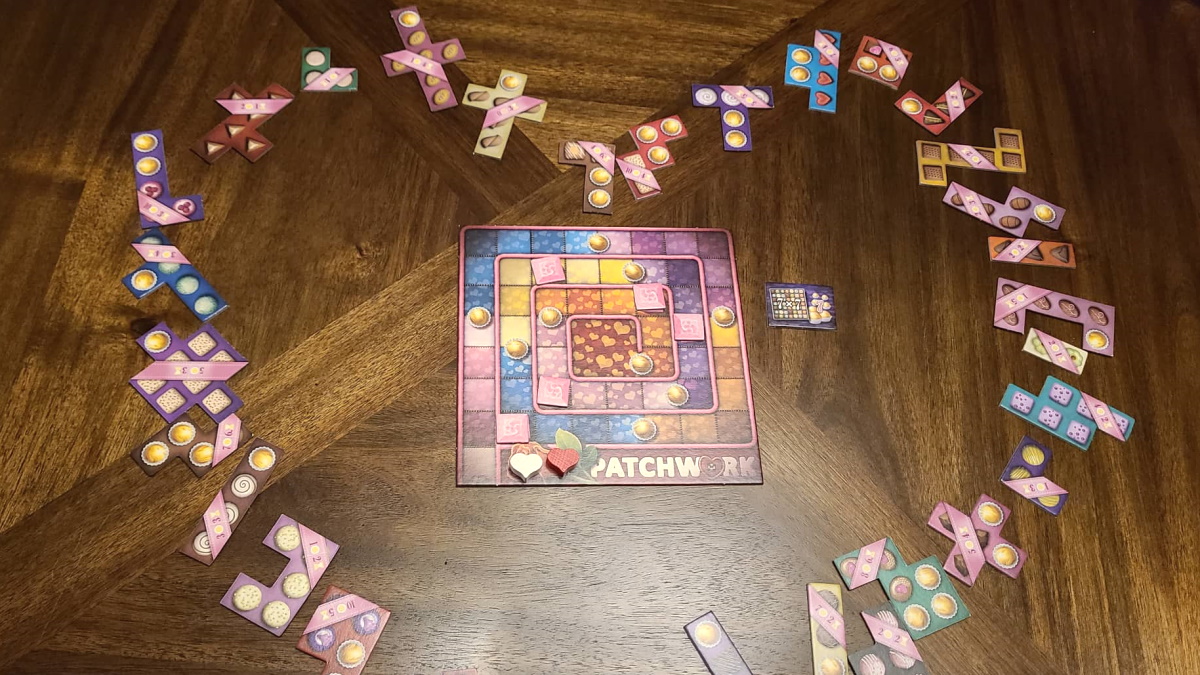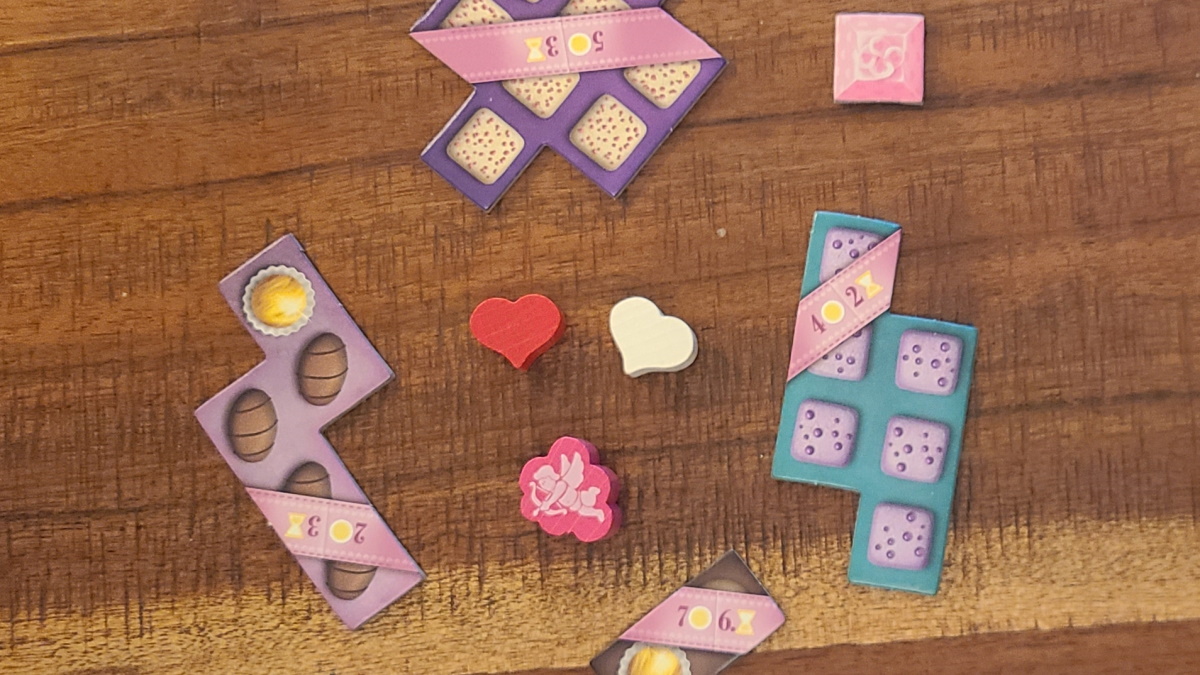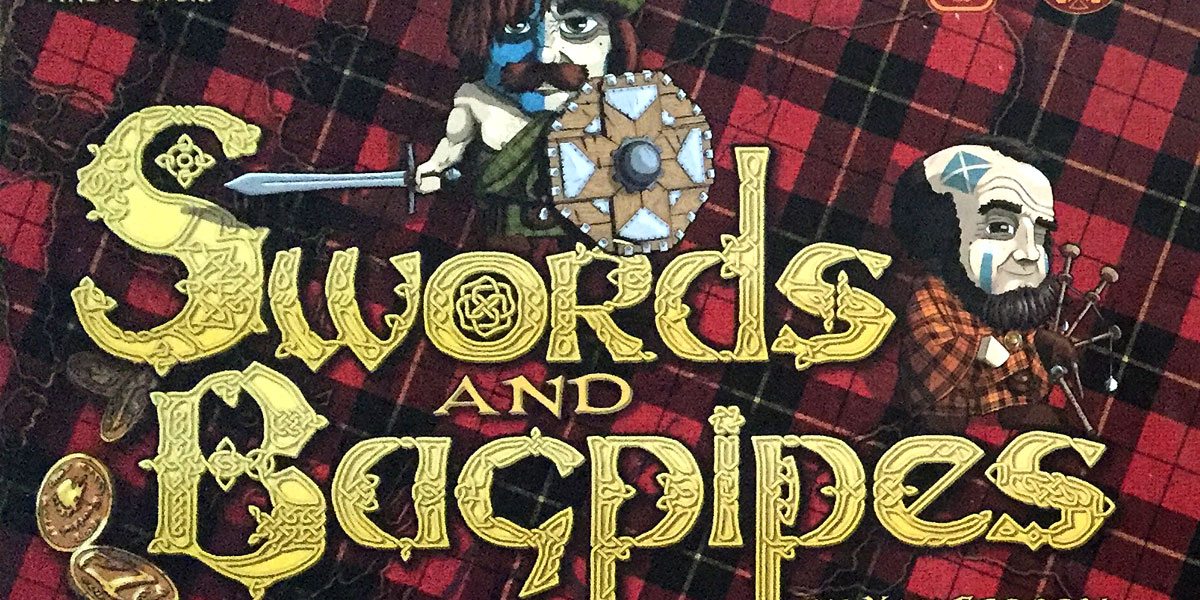Are you trying to recover from forgetting to buy your Valentine a Valentine’s present? We have the perfect Valentine’s gift for you, and a year ahead to boot!
What Is Patchwork Valentine Edition?
Patchwork Valentine Edition is a tile-placement game for 2 players, ages 8 and up, and it takes about 30 minutes to play. It is a retheme of the classic Uwe Rosenberg Patchwork game, using boxes of chocolates and pralines instead of quilts and buttons. It is a fast, fun game that is easy to teach and difficult to master, with several different layers of strategy you need to manage. I had the opportunity to play this game this past Valentine’s Day and really enjoyed it.
Patchwork was designed by Uwe Rosenberg and released in 2014. It is published by Lookout Games, and this Valentine Edition is one of several themed versions of the original game. Some of the other themes include winter, Halloween, and several folklore editions featuring different artwork. The graphic design of this edition is by atelier198.

It is currently available from your favorite game store, Amazon, or directly from Asmodee with a recommended price of $36.99.
Patchwork Valentine Edition Components
Here’s what is included in the box:
- 1 time board
- 2 box boards
- 2 heart tokens
- 1 neutral token
- 33 differently shaped pieces
- 5 petits fours
- 1 7×7 scoring tile
- 50 praline chits
- 1 rule book
In Patchwork Valentine Edition, rather than pieces of a quilt, your pieces are collections of chocolates to go on your box board. Rather than buttons, you will collect pralines. And instead of single cloth patches, you have petits fours to fill your open spaces in your box. The pieces serve the same purpose as the original game, but with a new theme to match Valentine’s Day. The theme itself works very well, as you can easily picture yourself putting all sorts of different chocolates into a chocolate box to give to your Valentine. The time board has different artwork pulling together the Valentine’s theme and the original quilting theme by representing the spaces as quilt pieces with hearts on them. The person I was playing the game with also mentioned that the theme actually felt like a better fit for her than the original.

The components are all very well crafted, as you would expect from a game of this pedigree. The cardboard is thick and should stand up well to multiple plays, and they all punched out easily without any snags or tears. The tokens are well made as well. Overall, I was very happy with the production quality of the game.

How to Play Patchwork Valentine Edition
You play this game just like the original Patchwork. Okay, on to the next section. Wait… you’ve never played Patchwork before? Well, guess what? Neither had I, so Patchwork Valentine Edition was my first introduction to this game and its unique mechanics.
You start by placing all the chocolate tiles around the time board, in random order. Each player takes a box board and the heart token in the matching color. The tokens are placed on the starting space on the time board. You place the neutral token (printed with cupid) between the smallest chocolate tile and whichever tile is next to it in a clockwise direction. Now you are ready to start. The rules say that officially the last player who ate chocolate should start, but since this is Valentine’s, I’d recommend that the player who forgot to buy the other a Valentine’s gift should be the last player to go.
In Patchwork Valentine Edition, and the other editions, of course, the time board is what controls play and turns. The time board is unique by controlling which player’s turn it is. While your token is not in the lead, it is your turn. During your turn, you can perform one of two moves. You can purchase a chocolate tile and place it on your chocolate box board. Depending on the tile you purchased, you will move your token along the spaces on the time board. If your token is still not in the lead, and you have the means to purchase another tile, you can do so. Your other turn choice is passing, which allows you to move your token until it is in the lead.
In Patchwork Valentine Edition, you use praline chits to purchase chocolate tiles, replacing the buttons in the original. Each tile has a small banner on it showing how many praline chits it costs to purchase, and how many moves your token will make along the time board if you do purchase it. During your turn, you can purchase and place multiple tiles, assuming you have enough pralines for the purchases and your token is still not in the lead.

Did you notice that some chocolate tiles you purchase have a graphic of one or more pralines on them? As you move around the time board, you will pass over praline symbols that are placed between certain spaces. Each time you move over a praline, you collect as many pralines as your chocolate tiles on your box board have pictured on them. For instance, if you have 5 tiles, with a total of 3 pralines, and your token passes a praline symbol on the time board, you would collect 3 pralines. This is how you obtain the pralines that will be used to purchase more chocolate tiles throughout the game.
There are also petit fours on the time board, which are little pink squares. If you are the first player to land on or move over a space with a petit four, you collect and immediately place it on your box board. These pieces play a very strategic role in filling holes on your board, and they take the place of the single cloth patches for those familiar with the original game.
Filling holes on your board is an important strategy as well, because as you fill your box board, the first player to complete a 7×7 square, with no holes in it, will collect the special 7×7 scoring tile that gives a bonus at the end of the game.
Did You Finish Your Box?
Patchwork Valentine Edition ends when the tokens for both players reach the middle space on the time board. You move over a praline symbol as you enter the space, and you will collect your last batch of pralines for final scoring.
Scoring is a simple matter. You count the number of praline chits you have at the end of the game and add the 7×7 scoring token if you have it. From this total, deduct two points for each open space that remains on your box board. This part is the killer because you can lose points VERY quickly, sometimes ending with a negative score. Whoever has the most points wins, and in the case of a tie, whoever entered the last space on the time board first wins.

My Two Cents for Patchwork Valentine Edition
Patchwork Valentine Edition is a very approachable game for everyone, and, of course, this Valentine Edition is a great gift for that special someone in your life who loves games, but always seems to buy them before you even get a chance to get them a gift! As you play Patchwork Valentine Edition, you will begin to see the different layers of strategy coming into play. Do you try to buy tiles with lots of pralines? Do you go for the 7×7 special tile? Do you try to maximize moves on the time board? Or do you just have fun and try to create pretty patterns out of chocolate. There is something here for almost every level of gamer, and after a few plays, it feels like a great game to introduce people to board games who may have avoided them in the past. The two-player aspect can be a bit of a hindrance for those of you with a regular group of people to play games with, but with as fast and approachable as Patchwork Valentine Edition is, it can actually be a great filler while you are waiting for those longer games to finish.
I don’t believe there is enough in Patchwork Valentine Edition to warrant a separate purchase if you already have another edition of Patchwork unless it satisfies the completionist in you. But if you don’t have Patchwork, or are buying a game for friends who don’t have Patchwork, the Valentine Edition would be just as much fun to play in July as it would be at Valentine’s Day. If I had to pick one gripe about the game, it would be that they only included one baggie for components, when similarly priced games always seem to include several these days. True, there are not a ton of components to separate, but I did find myself digging around for my extra bags to separate the pralines out from the rest of the tiles.
Click here to see all our tabletop game reviews.
![]() To subscribe to GeekDad’s tabletop gaming coverage, please copy this link and add it to your RSS reader.
To subscribe to GeekDad’s tabletop gaming coverage, please copy this link and add it to your RSS reader.
Disclosure: GeekDad received a copy of this game for review purposes.





